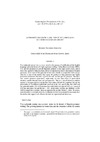Identificador persistente para citar o vincular este elemento:
https://accedacris.ulpgc.es/jspui/handle/10553/72675
| Campo DC | Valor | idioma |
|---|---|---|
| dc.contributor.author | Fernández Martínez, Dolores | en_US |
| dc.date.accessioned | 2020-05-20T15:51:28Z | - |
| dc.date.available | 2020-05-20T15:51:28Z | - |
| dc.date.issued | 2012 | en_US |
| dc.identifier.issn | 0081-6272 | en_US |
| dc.identifier.other | Scopus | - |
| dc.identifier.uri | https://accedacris.ulpgc.es/handle/10553/72675 | - |
| dc.description.abstract | The eighteenth century was a crucial period in the process of codification of the English language and in the history of English grammar writing (Tieken-Boon van Ostade 2008b). The need for grammars to provide linguistic guidance to the upper social classes, and to those who aspired to belong to them, led to an important increase in the output of English grammars. Since most of the grammar writers were clearly in competition with one another for a share of the market, they turned the prefaces to their grammars into highly persuasive instruments that tried to justify the need for that specific grammar. Priestley's and Lowth's grammars epitomized, respectively, the two main trends of grammatical tradition, namely descriptivism and prescriptivism. Taking a critical discourse analysis approach, this paper aims to examine how both writers claimed their authority through the presentation of the different individuals involved in the text, specifically, the author and any potential readers. We will examine how individuals are depicted both as a centre of structure and action through Martin's (1992) identification systems and Halliday's (2004 [1985]) transitivity structures. Such an approach fits in with Wicker's (2006: 79) assessment of prefaces as textual networks of authority in which it is essential to interrogate how the readers who support and influence the texts are represented and addressed. | en_US |
| dc.language | spa | en_US |
| dc.relation.ispartof | Studia Anglica Posnaniensia | en_US |
| dc.source | Studia Anglica Posnaniensia [ISSN 0081-6272], v. 47 (4), p. 97-111 | en_US |
| dc.subject | 5701 Lingüística aplicada | en_US |
| dc.title | Authority in lowth's and priestley's prefaces to their English Grammars | en_US |
| dc.type | info:eu-repo/semantics/Article | en_US |
| dc.type | Article | en_US |
| dc.identifier.doi | 10.2478/v10121-012-0013-9 | en_US |
| dc.identifier.scopus | 84936754169 | - |
| dc.contributor.authorscopusid | 55424657500 | - |
| dc.description.lastpage | 111 | en_US |
| dc.identifier.issue | 4 | - |
| dc.description.firstpage | 97 | en_US |
| dc.relation.volume | 47 | en_US |
| dc.investigacion | Artes y Humanidades | en_US |
| dc.type2 | Artículo | en_US |
| dc.utils.revision | Sí | en_US |
| dc.date.coverdate | Diciembre 2012 | en_US |
| dc.identifier.ulpgc | Sí | es |
| dc.description.sjr | 0,167 | |
| dc.description.sjrq | Q2 | |
| dc.description.erihplus | ERIH PLUS | |
| item.fulltext | Con texto completo | - |
| item.grantfulltext | open | - |
| crisitem.author.dept | GIR IATEXT: Variación y Cambio Lingüístico | - |
| crisitem.author.dept | IU de Análisis y Aplicaciones Textuales | - |
| crisitem.author.dept | Departamento de Filología Moderna, Traducción e Interpretación | - |
| crisitem.author.parentorg | IU de Análisis y Aplicaciones Textuales | - |
| crisitem.author.fullName | Fernández Martínez, Dolores | - |
| Colección: | Artículos | |
Los elementos en ULPGC accedaCRIS están protegidos por derechos de autor con todos los derechos reservados, a menos que se indique lo contrario.
